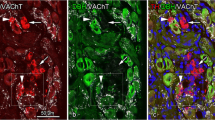Summary
The hypothalamohypophyseal system of the mouse, rat, guinea-pig, cat, dog and monkey (Macaca mulatta) was studied with the fluorescence method for catecholamine-containing neurons developed by Falck et al. (1962). The fluorescent fibers are prominent in the external layer and around the primary portal plexus of the infundibulum and in the peripheral region of the neural lobe of these animals, particulary on the external surface and surrounding the primary capillary loops. These fluorescent fibers are connected with fluorescent cells in the arcuate nuclei, and this connection coincides with the tuberohypophyseal system. The neurons of this system have a particular affinity for dopamine, possibly due to their own content of dopamine. In the supraoptic and paraventricular nuclei, no fluorescent cells were found. In the pars intermedia, we also found catecholamine-containing fibers.
The presence of catecholamine-containing fibers in the adeno- and neurohypophysis are considered in relation to other data derived from fluorescence and electron microscopy.
Similar content being viewed by others
References
Bargmann, W.: Zwischenhirn-Hypophysensystem, Neurosekretion und Nebenniere. Geburtsh. u. Frauenheilk. 13, 193–212 (1953).
Bertler, A., B. Falck, and E. Rosengren: The direct demonstration of a barrier mechanism in the brain capillaries. Acta pharmacol. (Kbh.) 20, 317–321 (1963).
Carlsson, A.: Functional significance of drug-induced changes in brain monoamine levels. Progr. Brain Res. 8, 9–27 (1964).
—, B. Falck, and N.-Å. Hillarp: Cellular localization of brain monoamines. Acta physiol. scand. 56, Suppl. 196, 1–28 (1962).
—, and M. Lindquist: In vivo decarboxylation of α-methyl dopa and α-methyl metatyrosine. Acta physiol. scand. 54, 87–94 (1962).
Dahlström, A.: Observations on the accumulation of noradrenaline in the proximal and distal parts of peripheral adrenergic nerves after compression. J. Anat. (Lond.) 99, 677–689 (1965).
-, and K. Fuxe: Evidence for the existence of monoamine-containing neurons in the central nervous system. 1. Demonstration of monoamines in the cell bodies of brain stem neurons. Acta physiol. scand. 62, Suppl. 232, 1–55.
—, L. Olson, and U. Ungerstedt: Ascending systems of catecholamine neurons from the lower brain stem. Acta physiol. scand. 62, 485–486 (1964).
Duffy, P. E., and M. Menefee: Electron microscopic observation of neurosecretory granules, nerve and glial fibers, and blood vessels in the median eminence of the rabbit. Amer. J. Anat. 117, 251–286 (1965).
Enemar, A., and B. Falck: On the presence of adrenergic nerves in the pars intermedia of the frog, Rana temporaria. Gen. comp. Endocr. 5, 577–583 (1965).
Eränkö, O., and M. Härkönen: Effect of axon division on the distribution of noradrenaline and acetylcholinesterase in sympathetic neurons of the rat. Acta physiol. 63, 411–412 (1965).
Falck, B.: Observations on the possibilities of the cellular localization of monoamines by a fluorescence method. Acta physiol. scand. 56, Suppl. 197, 1–25 (1962).
Fuxe, K.: Cellular localization of monoamines in the median eminence and the infundibular stem of some mammals. Z. Zellforsch. 61, 710–724 (1964).
—: Evidence for the existence of monoamine neurons in the central nervous system. III. The monoamine nerve terminal. Z. Zellforsch. 65, 573–596 (1965a).
—: Evidence for the existence of monoamine neurons in the central nervous system. IV. Distribution of monoamine nerve terminals in the central nervous system. Acta physiol. scand. 64, Suppl. 247, 37–84 (1965b).
—, and T. Hökfelt: Further evidence for the existence of tubero-infundibular dopamine neurons. Acta physiol. scand. 66, 245–246 (1966).
Greving, R.: Die zentralen Anteile des vegetativen Nervensystems. In: Handbuch der mikroskopischen Anatomie des Menschen, hrsg. v. W. v. Möllendorff, Bd. 4, Teil 1, S. 917–1060. Berlin: Springer 1928.
Guillemin, R.: On the hypothalmic neurohumor which controls the release of luteinizing hormone. Proc. Internat. Union Physiol. Sci., XXIIth Internat. Congr. Leiden 1962, S.629.
Hamberger, B., T. Malmfors, and Ch. Sachs: Standardization of paraformaldehyde and of certain procedures for the histochemical demonstration of catecholamines. J. Histochem. Cytochem. 13, 147 (1965).
Howe, A., and D. S. Maxwell: An electron microscopic study of the pars intermedia of the pituitary gland in the rat. J. Physiol. (Lond.) 183, 70–71 (1966).
Iturriza, F. C.: Monoamines and control of the pars intermedia of the toad pituitary. Gen. comp. Endocr. 6, 19–25 (1966).
Knoche, H.: Über das Vorkommen eigenartiger Nervenfasern (Nodulus-Fasern) in Hypophyse und Zwischenhirn von Hund und Mensch. Acta anat. (Basel) 18, 208–233 (1953).
Kobayashi, Y.: Functional morphology of the pars intermedia of the rat hypophysis as revealed with electron microscope. Z. Zellforsch. 68, 155–171 (1965).
Malmfors, T.: Studies on adrenergic nerves. Acta physiol. scand. 64, Suppl. 248, 1–93 (1965).
Sano, Y., N. Ishizaki, and K. Ito: Untersuchungen über die nichtgomoriphilen Nervenfasern im Hypothalamus-Hypophysensystem. I. Über die Nodulus-Fasern (Knoche) im Hypophysentrichter des Hundes. Arch. histol. jap. 11, 1–10 (1956).
- G. Odake, and T. Yonezawa: Fluorescence microscopic observations of catecholamines in cultures of the sympathetic chain. Z. Zellforsch. (in press) (1967a).
—, and S. Taketomo: Fluorescence microscopic and electron microscopic observations on the tuberohypophyseal tract. Neuroendocrin. 2, 30–42 (1967b).
Sawyer, C. H., J. E. Markee, and J. W. Everett: Activation of the adenohypophysis by intravenous injections of epinephrine in the atropinized rabbit. Endocrinol. 46, 536–543 (1950).
Scharrer, E.: Neurosecretion and anterior pituitary in the dog. Experientia (Basel) 10, 264–266 (1954).
—: Endocrine and the central nervous system. I. Principles of neuroendocrine integration. Ass. Res. nerv. Dis. Proc. 43, 1–35 (1966).
Spatz, H.: Das Hypophysen-Hypothalamus-System in seiner Bedeutung für die Fortpflanzung. Anat. Anz., Erg. 100, 46–86 (1953).
Szentágothai, J., B. Flerkó, B. Mess, and B. Halász: Hypothalamic control of the anterior pituitary. Budapest: Akadémiai Kiadó 1962.
—, and B. Halósz: Regulation des endokrinen Systems über den Hypothalamus. Nova Acta Leopoldina 28, 227–248 (1964).
Author information
Authors and Affiliations
Rights and permissions
About this article
Cite this article
Odake, G. Fluorescence microscopy of the catecholamine-containing neurons of the hypothalamohypophyseal system. Z. Zellforsch. 82, 46–64 (1967). https://doi.org/10.1007/BF00326100
Received:
Issue Date:
DOI: https://doi.org/10.1007/BF00326100




